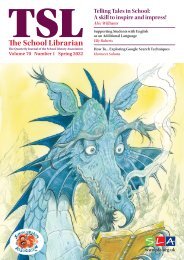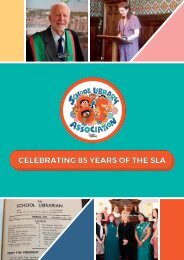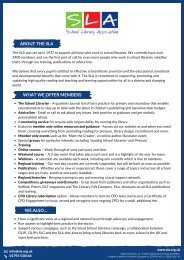TSL-67-4-WINTER-2019
Create successful ePaper yourself
Turn your PDF publications into a flip-book with our unique Google optimized e-Paper software.
Reviews
Editorial
Under 8
8 to 12
8 to 12 fiction
8 to 12 information
Poetry & Plays
12 to 16
12 to 16 fiction
12 to 16 information
16 to 19
Professional
Books and material for review
should be sent to:
Reviews Editor
1 Pine Court
Kembrey Park
Swindon SN2 8AD
216 The SL 67-4 Winter 2019
Image by Wokingham Libraries from Pixabay
One of the most significant pieces of research into UK children’s publishing
appeared in 2018. Reflecting Realities: Survey of Ethnic Representation within UK
Children’s Literature, produced by CLPE and led by Farrah Serroukh. The title was
inspired by a famous quote from Rudine Sims Bishop: ‘Books are sometimes
windows, offering views of worlds that may be real or imagined, familiar or strange.
When lighting conditions are just right, however, a window can also be a mirror.
Literature transforms human experience and reflects it back to us, and in that
reflection, we can see our own lives and experiences as part of a larger human
experience. Reading, then, becomes a means of self-affirmation, and readers often
seek their mirrors in books.’ In the past year ‘reflecting realities’ has become a
commonly used phrase to reflect the importance of all children being able to see
themselves in books.
The report caused quite a stir, even in the mainstream press, with its headline:
‘Only 1% of the children’s books published in the UK in 2017 had a BAME main
character’ and led to a Twitter campaign to #Readtheonepercent. When the reality
of life in the UK is that, according to GOV.UK statistics, 33.1% of pupils of school
age are of minority ethnic origins, you can see that our children’s books do not
reflect that population at all.
The second year of the survey, based upon 2018 production, has just been
published and in the intervening period Booktrust published Representation of
People of Colour among Children’s Book Authors and Illustrators which highlighted
the challenges and campaigned for more representation on the other side of the
equation: the creators of children’s literature. Together these reports have
galvanised the industry with new initiatives like CILIP’s new publication, Pen & Inc,
to actively promote diverse and inclusive publishing and the new criteria for the
CILIP Carnegie Medal. We have certainly also seen a difference in the books
submitted for review in this journal with more BAME authors and illustrators
coming through. We have actively pursued small minority publishers (which
incidentally explains why some books we feature are not newly published, but they
will be new to us and to a mainstream audience). Please also look at Varied Voices,
the brilliant new SLA Blog. This will be an inclusive place for diverse authors to talk
about their books, and the ideas and concepts behind them and every month
there’ll be another blog highlighting an author you might want to get to know.
Increasingly, I am glad to say, our reviewers, as in this edition, will comment
favourably or unfavourably on the representation in the books they are reviewing.
Pitfalls of poor representation are highlighted in the second CLPE report’s section
Reflecting on Content. Such things as exaggerated features that reduce images to
caricatures, oversimplified or inaccurate historical detail, homogenous palette
choices and bizarrely what they call the Jasmine Default. (A disproportionately high
number of female characters called Jasmine and how this appears to be the sole
reason the book was submitted for the survey!) But I wonder if the day will come
when we will take the stand that the famous Kirkus Reviews magazine adopted in
2015, when they started always identifying characters in children’s and teen books
they reviewed, by identity and/or race and thereby ‘unmasking the white default’?
You can understand the huge advantage in this, when parents and teachers want to
be able to find books where ethnic kids are just kids. But it does lead to clumsy and
cumbersome specificity in the reviews. Reviewers apparently are given special
training to help ‘identify problematic tropes and representations,’ and the reviews
themselves are increasingly assigned to what Kirkus calls ‘own voices’ reviewers. I
would be very interested to hear your views on how far we should go and how we
should set about it? At the moment, I don’t gather that sort of data on reviewers.
But nevertheless I hope that we would all agree that we need the highest quality
inclusive and representative literature for the benefit of all our young readers and
that this is what we want our TSL reviews to highlight.
Joy Court, Reviews Editor


















